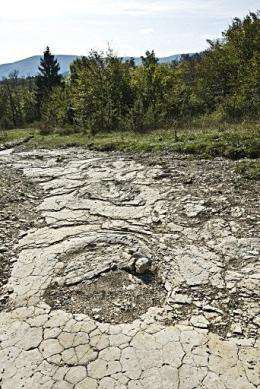Dino footprints enter record books

French researchers on Tuesday said they had uncovered the biggest dinosaur footprints in the world, left by giant sauropods that may have weighed 40 tonnes or more.
Footprints from sauropod dinosaurs, giant herbivores with long necks, were found in Plagne, near Lyon, France. Discovered by Marie-Hélčne Marcaud and Patrice Landry, two nature enthusiasts, the dinosaur footprints have been authenticated by Jean-Michel Mazin and Pierre Hantzpergue, both of the Paléoenvironnements et Paléobiosphčres laboratory (CNRS, France).
According to the researchers' initial analyses, these dinosaur footprints are the largest found to date. Furthermore, the tracks spread over dozens and possibly even hundreds of meters. More significant digs will be conducted over the next few years and could result in the Plagne site being one of the largest known dinosaur sites on earth.
Marie-Hélčne Marcaud, Patrice Landry and other members of the Société des naturalistes d'Oyonnax (SDNO) have been searching for dinosaur footprints for years. Convinced that the region had a rich paleontological heritage, they focused on potential sites and have been exploring them systematically.
It was during one of these outings, on April 5, 2009, that Marie-Hélčne Marcaud and Patrice Landry discovered the extraordinary footprints at Plagne. They contacted Jean-Michel Mazin and Pierre Hantzpergue, of the Paléoenvironnements et Paléobiosphčres laboratory. The researchers authenticated the footprints based on morphological criteria and the sediment containing them. They believe that the Plagne site was along a route used by sauropod dinosaurs. The dinosaur footprints in Plagne are circular depressions surrounded by a fold of limestone sediment. These depressions are very large, up to 1.50 m in total diameter, suggesting that the animals were larger than 40 tonnes and 25 meters in length. The limestone dates to the Tithonian stage (Upper Jurassic, -150MY), a period during which the area was covered by a warm and shallow sea. The discovery of these footprints shows that sauropods moved around during a phase of emersion of the area, when sea levels were low.
The Plagne site is exceptional, both for the size of the prints and the number of tracks which can be seen and those potentially left to discover. Geological studies and digs of such a large surface area require significant technical and human resources over several years.
Provided by CNRS


















